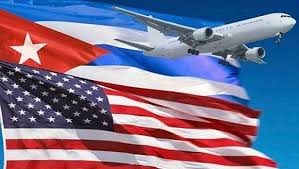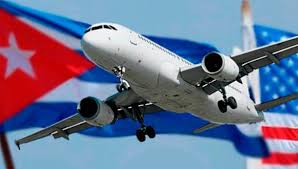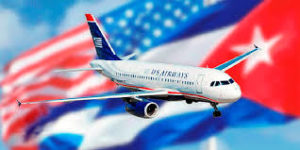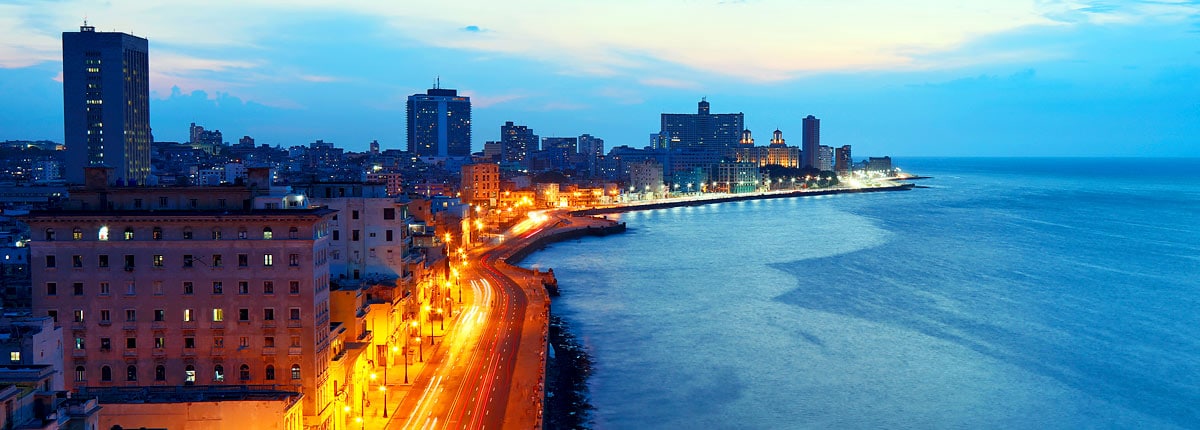 MAS DE 160,000 CUBANOS VIAJARON DESDE EEUU A CUBA EN LOS PRIMEROS CUATRO MESES DEL AÑO.
MAS DE 160,000 CUBANOS VIAJARON DESDE EEUU A CUBA EN LOS PRIMEROS CUATRO MESES DEL AÑO.
A pesar de las tensiones generadas por el drástico viraje en la política hacia Cuba, más de 400 mil viajeros procedentes de Estados Unidos, de ellos un 42 por ciento de cubanos y cubanoamericanos, visitaron la isla durante los primeros meses de 2019, indican reportes estadísticos.
En momentos de clara contracción del turismo europeo, 257 500 estadounidenses y más de 161 000 cubanos residentes en Estados Unidos viajaron a Cuba entre los meses de enero a abril del presente año, según datos combinados de la Oficina Nacional de Estadísticas e Información (ONEI), el Ministerio de Turismo (MINTUR) y la consultora The Havana Consulting Group (THCG), con sede en Miami.
Las cifras consolidan a Estados Unidos como el segundo emisor de turismo hacia Cuba (más de 417 000 viajeros), detrás de Canadá que sigue liderando el mercado con 624 530 visitantes durante el primer cuatrimestre del año. De hecho, entre Estados Unidos y Canadá acaparan el 80 % de los 1.9 millones de visitantes que han arribado a la isla en lo que va de año.
“Los viajeros de Estados Unidos y Canadá, y la comunidad cubana en el exterior, están sosteniendo el turismo cubano en estos momentos”, dijo a CiberCuba el economista Emilio Morales, presidente de THCG. “Lo que estamos viendo en el mercado turístico cubano no es una desaceleración sino un total declive”.
El gobierno cubano anunció un crecimiento del 7.2 por ciento en arribo de visitantes internacionales, a pesar de las “zancadillas de Washington” y “las dificultades en la zona europea”. El MINTUR se ha fijado como meta 5.1 millones de visitantes al término de 2019.
El repunte de estadounidenses es realmente significativo y representa el mayor crecimiento entre los países emisores (93.5%) en comparación con la misma etapa de 2018, a pesar de que los viajeros estadounidenses tienen que cumplir los requisitos establecidos por 12 categorías del Departamento del Tesoro para no violar las regulaciones del embargo, además de que Washington ha emitido una alerta de viaje para sus ciudadanos tras el incidente de los presuntos ataques sónicos que afectaron a 26 diplomáticos estadounidenses en La Habana.
Morales cree que el alza de visitantes estadounidenses está impulsada por la industria de los cruceros, que es una modalidad mucho más atractiva y confiable para el turista. Las estadísticas del MINTUR corroboran que el 55 % de los norteamericanos arriban al país en cruceros.
En cuanto a los viajeros cubanos y cubanoamericanos, los datos confirman un crecimiento continuo desde el 2009, cuando la administración de Barack Obama levantó las restricciones para visitas y remesas familiares que impuso su predecesor en la Casa Blanca, George W. Bush.El informe trimestral de ONEI (enero-marzo 2019) agrupa de manera general los 141 057 pasajeros registrados como miembros de la comunidad cubana en el exterior, sin especificar la cantidad de viajes familiares desde Estados Unidos. No obstante, fuentes del MINTUR dijeron que la afluencia de cubanos y cubanoamericanos alcanzó un comportamiento promedio hasta abril.
El 86 % de las visitas de la comunidad cubana en el exterior proviene de Estados Unidos.
Los registros de THCG, que monitorea los viajes desde Estados Unidos, indican que 122 454 cubanos visitaron la isla en el primer trimestre y unos 40 000 lo hicieron en abril, con un total combinado de viajeros de más de 162 000 viajeros.
Representantes de la industria de viajes a Cuba observan, incluso, un extraordinario aumento en el flujo de pasajeros desde Estados Unidos, coincidiendo con los planes de Washington para limitar categorías en las visitas autorizadas para estadounidenses, y restringir remesas y transacciones financieras hacia el país vecino. El Departamento del Tesoro trabaja actualmente en la elaboración de nuevas regulaciones que deben estar listas para julio.
“El mercado se ha comportado de una forma extraordinaria, mucho más activo que el pasado año”, dijo a CiberCuba la empresaria Xiomara Almaguer, presidenta de Xael Charters, con sede en Miami. “No tenemos espacio en los aviones”.
Xael Charters es la principal firma de vuelos fletados que comparte el negocio de los viajes a Cuba con una decena de aerolíneas estadounidenses autorizadas por el Departamento de Transporte de Estados Unidos, en 2016. La entidad realiza semanalmente vuelos a La Habana, Camagüey, Holguín y Santa Clara. “Esto es un verdadero plebiscito”, comentó Almaguer. “La gente quiere seguir viajando a Cuba a ver a su familia”.
Las señales de la industria son firmes hasta el momento. El pasado viernes, American Airlines realizó desde Miami su vuelo inaugural de una ruta diaria a la ciudad de Santiago de Cuba. El vuelo, con 143 pasajeros a bordo, fue el resultado de tres años de negociaciones de la aerolínea y las autoridades cubanas.
Pero este panorama relativamente alentador para el MINTUR pudiera dar un vuelco radical para mediados de año como resultado de las sanciones anunciadas por la Casa Blanca. El presidente Donald Trump llegó hasta amenazar con un “embargo total” si el gobierno cubano no cesa su respaldo e intromisión en la crisis de Venezuela. “Los viajes de los cubanoamericanos se han disparado mucho más que en el resto de la comunidad cubana en el exterior después que Trump anunció el cambio de política hacia Cuba… La gente se desespera y se apresura a viajar pensando en que el panorama se va a volver a cerrar”.
De cualquier manera, el verano va a ser un termómetro importante para el comportamiento de los viajes desde Estados Unidos a Cuba. Las próximas medidas del Departamento del Tesoro afectarían mayormente a los pasajeros estadounidenses, con una drástico recorte probablemente a la mitad de las categorías autorizadas para visitar la isla.
 MORE THAN 160,000 CUBANS TRAVELED FROM THE USA TO CUBA IN THE FIRST FOUR MONTHS OF THE YEAR.
MORE THAN 160,000 CUBANS TRAVELED FROM THE USA TO CUBA IN THE FIRST FOUR MONTHS OF THE YEAR.
Despite the tensions generated by the drastic turn in Cuba policy, more than 400 thousand travelers from the United States, of the 42 percent of Cubans and Cuban Americans, visited the island during the first months of 2019, according to statistical reports. .
At a time of clear contraction of European tourism, 257,500 Americans and more than 161,000 Cubans living in the United States traveled to Cuba between the months of January to April of this year, according to combined data from the National Office of Statistics and Information (ONEI) , the Ministry of Tourism (MINTUR) and the consultancy The Havana Consulting Group (THCG), based in Miami.
The figures consolidate the United States as the second issuer of tourism to Cuba (more than 417,000 travelers), behind Canada that continues to lead the market with 624,530 visitors during the first four months of the year. In fact, between the United States and Canada, they account for 80% of the 1.9 million visitors who have arrived on the island so far this year.
“Travelers from the United States and Canada, and the Cuban community abroad are holding Cuban tourism at the moment,” economist Emilio Morales, president of THCG, told CiberCuba. “What we are seeing in the Cuban tourist market is not a slowdown but a total decline.”
The Cuban government announced a growth of 7.2 percent in the arrival of international visitors, despite the “trips from Washington” and “the difficulties in the European zone.” MINTUR has set a goal of 5.1 million visitors by the end of 2019.
The rise of Americans is really significant and represents the highest growth among the issuing countries (93.5%) compared to the same period of 2018, despite the fact that US travelers have to meet the requirements established by 12 categories of the Treasury Department. not violate embargo regulations, in addition to Washington has issued a travel alert for its citizens after the incident of alleged sonic attacks that affected 26 US diplomats in Havana.
Morales believes that the increase in American visitors is driven by the cruise industry, which is a much more attractive and reliable modality for tourists. MINTUR statistics corroborate that 55% of Americans arrive in the country on cruises.
As for Cuban and Cuban-American travelers, the data confirm a continuous growth since 2009, when the Barack Obama administration lifted restrictions for family visits and remittances imposed by his predecessor in the White House, George W. Bush. The quarterly report of ONEI (January-March 2019) groups in a general way the 141 057 passengers registered as members of the Cuban community abroad, without specifying the number of family trips from the United States. However, MINTUR sources said that the influx of Cubans and Cuban Americans reached an average behavior until April.
86% of the visits of the Cuban community abroad come from the United States.
The THCG records, which monitor travel from the United States, indicate that 122,454 Cubans visited the island in the first quarter and about 40,000 did so in April, with a combined total of travelers of more than 162,000 travelers.
Representatives of the travel industry to Cuba observe, even, an extraordinary increase in the flow of passengers from the United States, coinciding with the plans of Washington to limit categories in authorized visits for Americans, and restrict remittances and financial transactions to the neighboring country. . The Treasury Department is currently working on the preparation of new regulations that should be ready by July.
“The market has behaved in an extraordinary way, much more active than last year,” Xiomara Almaguer, president of Xael Charters, based in Miami, told CiberCuba. “We do not have space on the planes.”
Xael Charters is the main firm of chartered flights that shares the business of travel to Cuba with a dozen US airlines authorized by the US Department of Transportation, in 2016. The entity makes weekly flights to Havana, Camaguey, Holguin and Santa Clara “This is a true plebiscite,” said Almaguer. “People want to continue traveling to Cuba to see their family.”
The signs of the industry are firm so far. Last Friday, American Airlines made its inaugural flight from Miami to the city of Santiago de Cuba. The flight, with 143 passengers on board, was the result of three years of negotiations between the airline and the Cuban authorities.
But this relatively encouraging outlook for MINTUR could turn around radically by mid-year as a result of the sanctions announced by the White House. President Donald Trump even threatened a “total embargo” if the Cuban government does not cease its support and interference in the Venezuelan crisis. “The trips of the Cuban-Americans have shot up much more than in the rest of the Cuban community abroad after Trump announced the change of policy towards Cuba … People are desperate and are rushing to travel thinking that the outlook is it’s going to close again. ”
Either way, summer is going to be an important thermometer for the behavior of travel from the United States to Cuba. The Treasury Department’s next steps would affect mostly US passengers, with a drastic cut probably to half the categories authorized to visit the island.
Agencies/ CiberCuba/ Wilfredo Cancio/ Extractos/ Excerpts/ Internet Photos/ Arnoldo Varona/ www.TheCubanHistory.com
THE CUBAN HISTORY, HOLLYWOOD.



 < MORE Than 160,000 Cubans Traveled from U.S. to Cuba in the First 4 Months of the Year.
< MORE Than 160,000 Cubans Traveled from U.S. to Cuba in the First 4 Months of the Year.



